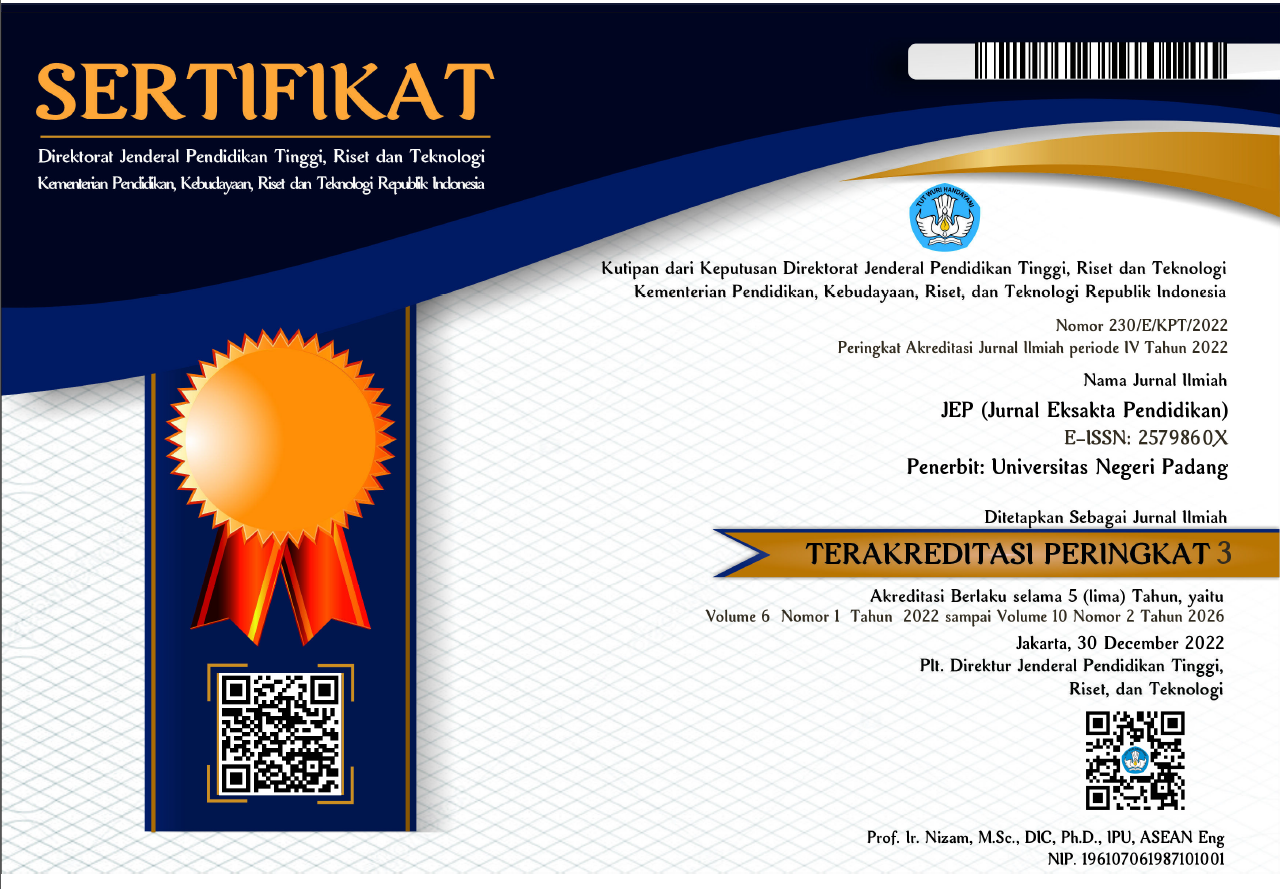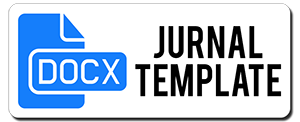Problem Based Learning to Improve Creative Thinking Skills and Technological Literacy on Virus Material
Abstract
Creative thinking skills and technological literacy are important skills possessed by students in the 21st century. However, many students are still poorly trained these skills, so they need learning strategy that can improve them. This classroom action research aims to improve creative thinking skills and technological literacy through the application of PBL. The method used is Stephen Kemmis and Robyn McTaggart (2007) model, includes planning, acting, observing and reflecting stages in each cycle. The research subjects were 34 students of class X-10 State Senior High School 1 Batu. The results obtained in the form of the average value of creative thinking skills in the precycle of 55.37%, cycle I of 73.97%, while in cycle II of 84.19%, while the average score of technological literacy in the precycle of 66.43, cycle I of 75.62, while in cycle II of 87.68. This shows that the application of PBL can improve creative thinking skills and technological literacy in students of Class X-10 State Senior High School 1 Batu. The implication of this research is that the application of PBL develops problem solving skills, creative thinking in formulating solutions, and being able to utilize the role of technology appropriately so that students can continue to adapt in the digital era.
Downloads
References
Arends, R. I. (2012). Learning to Teach 9. ed. Avenue of the Americas, New York, NY: Me Grew Hill.
Arifin, S., Kartono, K., & Hidayah, I. (2019). The Analysis of Problem Solving Ability in Terms of Cognitive Style in Problem Based Learning Model with Diagnostic Assessment. Unnes Journal of Mathematics Education Research, 8(2), 147–156.
Asrori, A., & Rusman, R. (2020). Classroom Action Research: Pengembangan Kompetensi Guru. Banyumas: Pena Persada.
Aytaç, T., & Kula, S. S. (2020). The Effect of Student-Centered Approaches on Students’ Creative Thinking Skills: A Meta-Analysis Study. International Journal of Contemporary Educational Research, 7(2), 62–80.
Cintia, N. I., Kristin, F., & Anugraheni, I. (2018). Penerapan Model Pembelajaran Discovery Learning untuk Meningkatkan Kemampuan Berpikir Kreatif dan Hasil Belajar Siswa. Perspektif Ilmu Pendidikan, 32(1), 67–75.
Daga, A. T. (2022). Penguatan Peran Guru dalam Implementasi Kebijakan Merdeka Belajar di Sekolah Dasar. ELSE (Elementary School Education Journal): Jurnal Pendidikan dan Pembelajaran Sekolah Dasar, 6(1), 1–24.
Djaali, H., & Muljono, P. (2008). Pengukuran dalam Bidang Pendidikan. Jakarta: Grasindo, 2(8), 55.
Doyle, M. A. (2013). Marie M. Clay’s theoretical perspective: A literacy processing theory. In. DE Alvermann & RB Ruddell (Eds.), Theoretical models and processes of reading 6th ed.(pp. 636–656). International Reading Association.
Farisi, A., Hamid, A., & Melvina, M. (2017). Pengaruh Model Pembelajaran Problem Based Learning Terhadap Kemampuan Berpikir Kritis dalam Meningkatkan Hasil Belajar Siswa pada Konsep Suhu Dan Kalor. Jurnal Ilmiah Mahasiswa Pendidikan Fisika, 2(3), 283–287.
Greenstein, L. M. (2012). Assessing 21st Century Skills: A Guide to Evaluating Mastery and Authentic Learning. Corwin Press.
Griffin, P., & Care, E. (2014). Assessment and Teaching of 21st Century Skills: Methods and Approach. Springer.
Herdiawan, H., Langitasari, I., & Solfarina, S. (2019). Penerapan PBL untuk Meningkatkan Keterampilan Berpikir Kreatif Siswa pada Konsep Koloid. EduChemia (Jurnal Kimia Dan Pendidikan), 4(1), 24–35.
Indraswati, D., Marhayani, D. A., Sutisna, D., Widodo, A., & Maulyda, M. A. (2020). Critical Thinking dan Problem Solving dalam Pembelajaran IPS untuk Menjawab Tantangan Abad 21. In Jurnal Pendidikan Sosial (Vol. 7).
Irdalisa, I., Anjani, F., Elvianasti, M., & Maesaroh, M. (2022). Pembelajaran Daring: Dampaknya Terhadap Berpikir Kreatif Siswa Dalam Menyelesaikan Masalah. Jurnal Eksakta Pendidikan (JEP), 6(1), 36–43.
Kemmis, S., McTaggart, R., & Nixon, R. (2014). The Action Research Planner: Doing Critical Participatory Action Research. Springer.
Kuo, F.-R., & Hwang, G.-J. (2014). A Five-Phase Learning Cycle Approach to Improving the Web-Based Problem-Solving Performance of Students. Journal of Educational Technology & Society, 17(1), 169–184.
Latip, A. (2020). Peran Literasi Teknologi Informasi dan Komunikasi pada Pembelajaran Jarak Jauh Di Masa Pandemi Covid-19. EduTeach: Jurnal Edukasi dan Teknologi Pembelajaran, 1(2), 108–116.
Lee, S., Kuo, L.-J., Xu, Z., & Hu, X. (2022). The Effects of Technology-Integrated Classroom Instruction on K-12 English Language Learners’ Literacy Development: A Meta-Analysis. Computer Assisted Language Learning, 35(5–6), 1106–1137.
Lewinsohn, C. R. F., Gislene, G., Leonardo, R. J., Johannes, K., Gerhard, E., Daniela, P., & Wolfgang, W. W. (2015). The Effectiveness of Applying The Future Problem Solving Program to Solve A Wide Range of Future Environmental Problems Among Students Who Are Illiterate. The Royal Swedish Academy of Sciences. AMBIO, 44, 154–162.
Madani, M. U., & Ardianti, R. (2021). Teknik Parafrase dalam Ketrampilan Menulis Untuk Menghindari Plagiarisme. Prosiding Seminar Nasional Pembelajaran Bahasa dan Sastra Indonesia (SemNas PBSI)-3, 343–344. FBS Unimed Press.
Mardiansyah, F., Haryanto, H., & Gusti, D. R. (2022). Pengaruh Model Pembelajaran Problem Based Learning (PBL) dan Kemampuan Pemecahan Masalah Terhadap Kemampuan Berpikir Kreatif Siswa pada Materi Larutan Penyangga. Journal on Teacher Education, 4(2), 293–303.
Marliani, N. (2015). Peningkatan Kemampuan Berpikir Kreatif Matematis Siswa Melalui Model Pembelajaran Missouri Mathematics Project (MMP). Formatif: Jurnal Ilmiah Pendidikan MIPA, 5(1).
Minsih, M. (2018). Peran Guru dalam Pengelolaan Kelas. Profesi Pendidikan Dasar, 5(1), 20–27.
Montag-Smit, T., & Maertz Jr, C. P. (2017). Searching Outside the Box in Creative Problem Solving: The Role of Creative Thinking Skills and Domain Knowledge. Journal of Business Research, 81, 1–10.
Ningrum, I. P., & Marsinun, R. (2022). Penerapan Model Pembelajaran Problem Based Learning untuk Meningkatkan Kemampuan Berpikir Kreatif Siswa. Jurnal Basicedu, 6(5), 8205–8214.
Nuraini, R., Pattiasina, P. J., & Ulfah, A. (2022). Peran Literasi Teknologi dalam Dunia Pendidikan. Al-Madrasah: Jurnal Pendidikan Madrasah Ibtidaiyah, 6(3), 659–666.
Nurasiah, N., Paristiowati, M., Erdawati, E., & Afrizal, A. (2023). Integration of Technology in Problem-Based Learning to Improve Students Computational Thinking: Implementation on Polymer Topics. International Journal of Social and Management Studies, 4(2), 65–73.
Ozdamar-Keskin, N., Ozata, F. Z., Banar, K., & Royle, K. (2015). Examining Digital Literacy Competences and Learning Habits of Open and Distance Learners. Contemporary Educational Technology, 6(1), 74–90.
Putu, R. (2013). Pengaruh Model Pembelajaran Kontekstual Berbantuan Tutor Sebaya Terhadap Hasil Belajar Biologi Ditinjau dari Motivasi Belajar. Jurnal Pendidikan Dan Pembelajaran IPA Indonesia, 3(1).
Ramda, A. H., Delima, M., & Nendi, F. (2022). Dampak PBL Bermuatan Tutor Sebaya Terhadap Peningkatan Kemampuan Pemecahan Masalah Siswa SMP. Jurnal Pendidikan Dan Kebudayaan Missio, 14(2), 190–203.
Riduwan, M. B. A. (2003). Dasar-Dasar Statistika. Bandung: Alfabeta.
Rosanti, D. (2018). Penerapan Metode Pembelajaran Tutor Sebaya untuk Meningkatkan Aktivitas dan Hasil Belajar Siswa di SMA Negeri 9 Pontianak. Jurnal Pendidikan Matematika dan IPA, 9(2), 1–10.
Rosnaeni, R. (2021). Karakteristik dan Asesmen Pembelajaran Abad 21. Jurnal Basicedu, 5(5), 4334–4339.
Sahida, D. (2018). Pengembangan Lembar Kerja Peserta Didik Berbasis Problem Based Learning Berbantuan Komik untuk Meningkatkan Creative Thinking Skill Peserta Didik pada Materi Gerak Lurus. Jurnal Eksakta Pendidikan (JEP), 2(1), 9–16.
Santoso, A., & Lestari, S. (2019). The Roles of Technology Literacy and Technology Integration to Improve Students’ Teaching Competencies. KnE Social Sciences, 243–256.
Setyaningrum, W., Riani, A. L., & Wardani, D. K. (2020). Efektivitas Model Pembelajaran Problem Based Learning (PBL) Ditinjau dari Curiosity, Kemampuan Berfikir Tingkat Tinggi, dan Kompetensi Peserta Didik. PROCEEDING UMSURABAYA.
Shopova, T. (2014). Digital Literacy of Students and Its Improvement at the University. Journal on Efficiency and Responsibility in Education and Science, 7(2), 26–32.
Subhan, S. (2022). Peningkatan Kompetensi Guru Menerapkan Pembelajaran Berdiferensiasi untuk Mewujudkan Merdeka Belajar Melalui Lokakarya di SMPN 3 Pontianak. Jurnal Pembelajaran Prospektif, 7(1).
Sugiarto, S., Aini, R. Q., & Suhendra, R. (2023). Pelatihan Impelemtasi Asesmen Diagnostik Mata Pelajaran Bahasa Indonesia Bagi Guru Sekolah Dasar di Kecamatan Taliwang. KARYA: Jurnal Pengabdian Kepada Masyarakat, 3(1), 76–80.
Sumarni, W., Wijayati, N., & Supanti, S. (2019). Analisis Kemampuan Kognitif Dan Berpikir Kreatif Siswa Melalui Pembelajaran Berbasis Proyek Berpendekatan STEM. J-PEK (Jurnal Pembelajaran Kimia), 4(1), 18–30.
Suwono, H., Rizkita, L., & Susilo, H. (2017). Peningkatan Literasi Saintifik Siswa SMA Melalui Pembelajaran Biologi Berbasis Masalah Sosiosains. Jurnal Ilmu Pendidikan, 21(2).
Tohani, E., & Aulia, I. (2022). Effects of 21st Century Learning on the Development of Critical Thinking, Creativity, Communication, and Collaboration Skills. Journal of Nonformal Education, 8(1).
Utomo, B. (2023). Implementation of Problem-Based Learning to Develop Students Creative Thinking Ability. Journal of Education Method and Learning Strategy, 1(01), 9–18.
Vekli, G. S., & Çimer, A. (2017). High School Students’ Written Argumentation Qualities with Problem-Based Computer-Aided Material (PBCAM) Designed about Human Endocrine System. Universal Journal of Educational Research, 5(5), 848–861.
Wahyudi, E. E., Aminah, N. S., & Sukarmin, S. (2018). Pembelajaran Optika Geometri Melalui Problem Based Learning (PBL) Ditinjau dari Kemampuan Berpikir Kritis Siswa dan Kemampuan Berpikir Kreatif Siswa SMA Kelas X Tahun 2014/2015. Inkuiri: Jurnal Pendidikan IPA, 6(3), 49–60.
Wahyuni, A., & Kurniawan, P. (2018). Hubungan Kemampuan Berpikir Kreatif Terhadap Hasil Belajar Mahasiswa. Matematika: Jurnal Teori dan Terapan Matematika, 17(2).
Wahyuni, N. C. (2018). Ketika plagiarisme adalah suatu permasalahan etika when plagiarism is a matter of ethics. Record And Library Journal, 4(1), 7–14.
Wali, G. N. K., Winarko, W., & Murniasih, T. R. (2020). Peningkatan Keaktifan dan Hasil Belajar Siswa dengan Penerapan Metode Tutor Sebaya. RAINSTEK: Jurnal Terapan Sains & Teknologi, 2(2), 164–173.
Wijayanto, P. W., Priyatiningsih, N., Herman, H., Sudadi, S., & Saputra, N. (2023). Implementation of Problem Based Learning Model to Improve Early Childhood Abilities in Creative Thinking. Jurnal Obsesi : Jurnal Pendidikan Anak Usia Dini, 7(1), 1017-1023.
Yang, J., & Zhao, X. (2021). The Effect of Creative Thinking on Academic Performance: Mechanisms, Heterogeneity, and Implication. Thinking Skills and Creativity, 40, 100831.
Yazon, A. D., Ang-Manaig, K., Buama, C. A. C., & Tesoro, J. F. B. (2019). Digital Literacy, Digital Competence and Research Productivity of Educators. Universal Journal of Educational Research, 7(8), 1734–1743.
Yew, E. H. J., & Goh, K. (2016). Problem-based learning: An overview of its process and impact on learning. Health Professions Education, 2(2), 75–79.
Yulianingtias, H. P., Tiwow, V. M. A., & Diah, A. W. M. (2016). Pengaruh Model Problem-Based Learning (PBL) Terhadap Keterampilan Berpikir Kreatif dan Hasil Belajar Siswa Pelajaran IPA Kelas VII SMP Negeri 3 Palu. Mitra Sains, 4(2), 62–70.
Zubaidah, S. (2018). Mengenal 4C: Learning and Innovation Skills untuk Menghadapi Era Revolusi Industri 4.0. 2nd Science Education National Conference, 13(2), 1–18.
Copyright (c) 2023 Zelvia Aprima Putri, Dewi Insyasiska, Poncojari Wahyono

This work is licensed under a Creative Commons Attribution 4.0 International License.

This work is licensed under a Creative Commons Attribution 4.0 International License.




_(2579-860X).png)
_(2614-1221)1.png)




